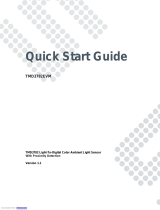Page is loading ...

2 3
click™
BOARD
www.mikroe.com
2. Soldering the headers
3. Plugging the board in
Once you have soldered the headers your
board is ready to be placed into the desired
mikroBUS™ socket. Make sure to align the cut in
the lower-right part of the board with the
markings on the silkscreen
at the mikroBUS™ socket.
If all the pins are aligned
correctly, push the board all
the way into the socket.
Turn the board upward again. Make sure
to align the headers so that they are
perpendicular to the board, then solder the
pins carefully.
Turn the board upside down so that
the bottom side is facing you upwards.
Place shorter pins of the header into the
appropriate soldering pads.
Before using your click™ board, make sure
to solder 1x8 male headers to both left and
right side of the board. Two 1x8 male headers
are included with the board in the package.
4. Essential features
All Tilt click™ does is tell you whether it’s
leaning left, right, forward or backward
at a given moment. The optical type of
direction detector it employs is highly
reliable. Compared to mechanical solutions,
optical direction detectors are less prone
to noise caused by vibrations. Compared to
magnetic-based direction detectors, they
are not inuenced by magnetic disturbances.
This makes Tilt click™ a robust and simple to
implement solution for all those that need
direction detection without the need for
highly precise positional measurements.
1
Tilt click™ carries RPI-1035, a 4-directional
optical tilt sensor. This type of sensor
provides positional feedback for left, right,
forward or backward movements. Tilt
click™ communicates with the target board
microcontroller through mikroBUS™ PWM
and INT lines, used here for Vout1 and Vout2
outputs from the sensor. In addition, two
onboard LEDs provide visual feedback from
the sensor. The board can use either a 3.3V
or 5V power supply.
Tilt click™
1. Introduction
TILT click™ manual
ver 1.00
0100000073872
Downloaded from Arrow.com.

GND GND
VCC
J1
R1
2K2
LD1
GND
AN
RST
CS
SCK
MOSI
MISO
+3.3V
GND
PWM
INT
RX
TX
SCL
SDA
+5V
GND
MIKROBUS DEVICE CONN.
1
2
3
4
6
5
U1
RPI-1035
R3 22K
R2 22K
GND GND
VCCVCC
R4 150
VCC
GND
Vout2Vout1
Vout2
Vout1
VCC
GND
R6
2K2
R1
R2
Q1
PDTC114EU
GND
R5
2K2
R1
R2
Q2
PDTC114EU
Vout2
Vout1
LD2
LD3
VCC
VCC
C1
100nF
GND
VCC
8. Code examples
MikroElektronika oers free tech support
(www.mikroe.com/support) until the end of
the product’s lifetime, so if something goes
wrong, we’re ready and willing to help!
Once you have done all the necessary
preparations, it’s time to get your click™ board
up and running. We have provided examples
for mikroC™, mikroBasic™ and mikroPascal™
compilers on our Libstock website. Just
download them and you are ready to start.
.com
6. Dimensions
MikroElektronika assumes no responsibility
or liability for any errors or inaccuracies
that may appear in the present document.
Specication and information contained in
the present schematic are subject to change
at any time without notice.
Copyright © 2015 MikroElektronika.
All rights reserved.
mm mils
LENGTH 28.5 1122
WIDTH 25.4 1000
HEIGHT 4 157.5
5. Schematic
7. SMD jumper 10. Disclaimer
9. Support
25.4 mm / 1000 mils
28.5 mm / 1122 mils
There is one zero-
ohm SMD jumper
J1 used to select
whether 3.3V or 5V
I/O voltage level is
used. Jumper J1
is soldered in 3.3V position by default.
Downloaded from Arrow.com.Downloaded from Arrow.com.
/
